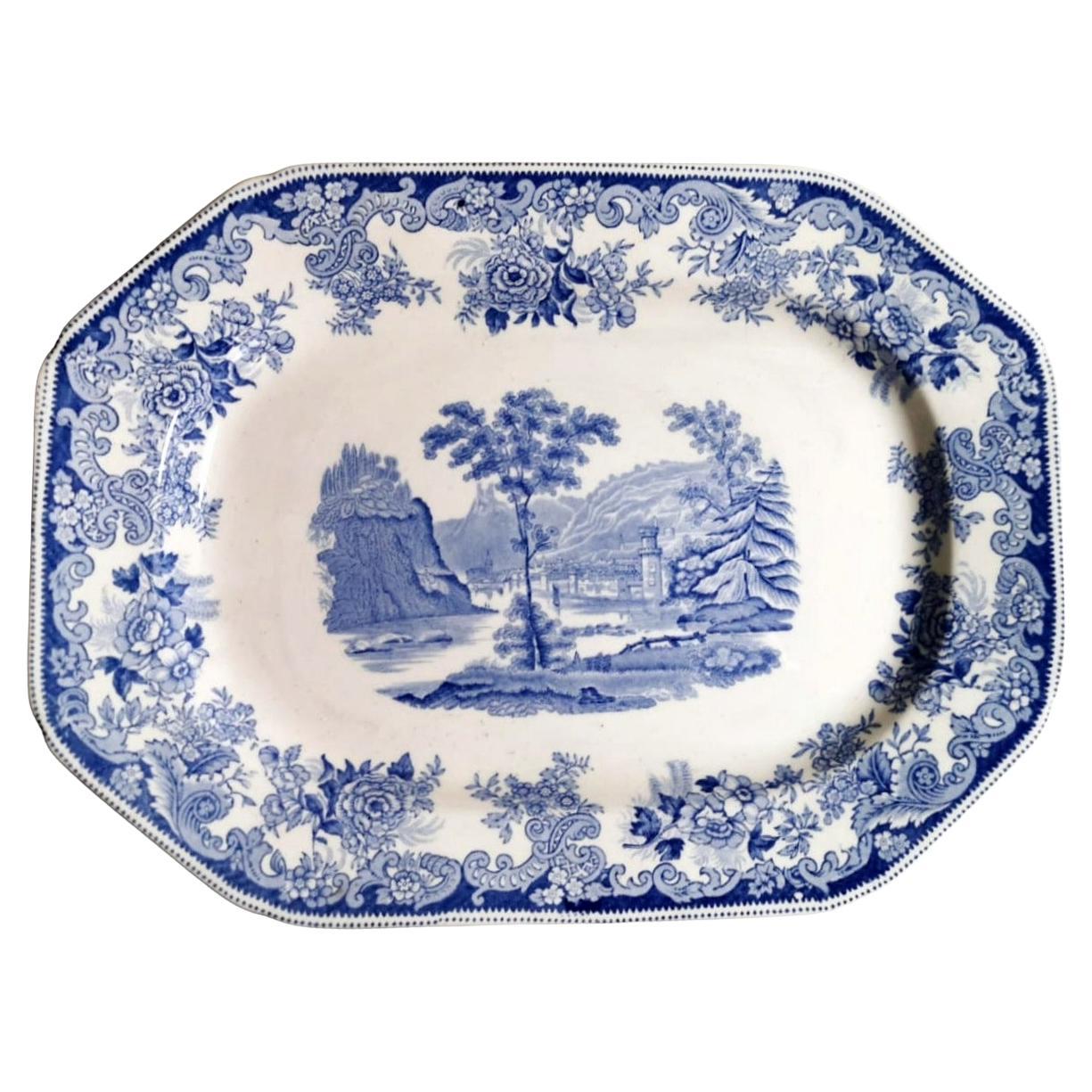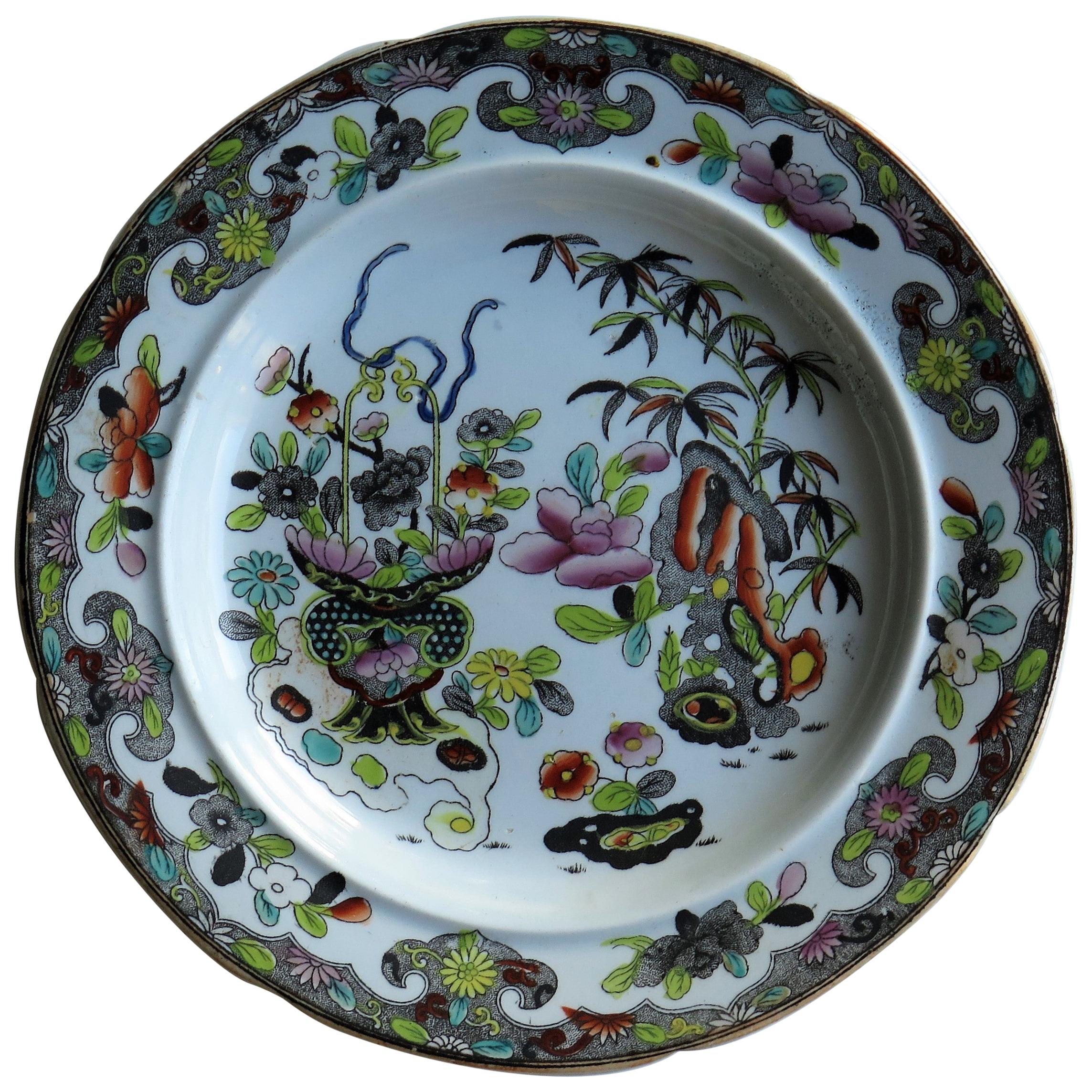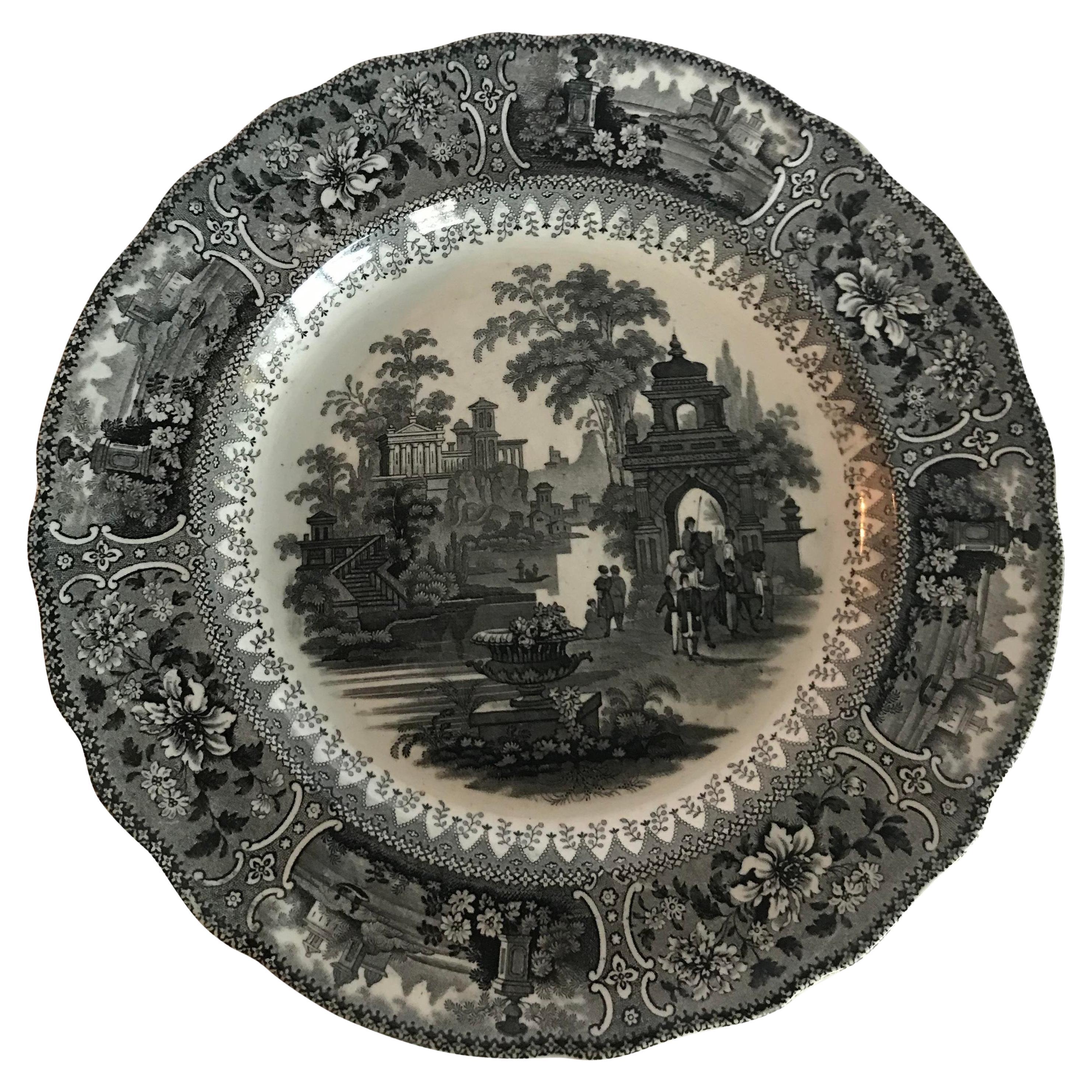Items Similar to Victorian Style Set 4 English Plates Transferware Decorations Royal Arms Mark
Want more images or videos?
Request additional images or videos from the seller
1 of 18
Victorian Style Set 4 English Plates Transferware Decorations Royal Arms Mark
About the Item
We kindly suggest you read the whole description, as with it we try to give you detailed technical and historical information to guarantee the authenticity of our items.
Refined and elegant English decorative ceramic plates; the set consists of two 27 cm.27 diameter plates and two 22 cm.22 plates; perfect for hanging on the wall. The plates were decorated using the "transferware" method, this type of work refers to glazed and decorated pottery with a specific treatment that they produced in Staffordshire England; they used copper plates on which the design was engraved, the plate was then inked and the design transferred to a special fabric that was later placed on the pottery (plates, trays, soup tureens etc.) which was glazed and fired; the first to use this printing process were John Sadler and Guy Verde of Liverpool in 1756. If we look at ceramics made by this method we will notice that the designs are not perfect and often the ink is smudged; this is their characteristic. A hand-painted plate service could afford to a few English families, with this method even middle-class families could have a decorated plate service. Our plates, after transferware processing (which was only blue) were hand-finished with soft, refined colors and then fired again in the kiln to fix the coloring; these additional steps made them even more precious and unique. They were produced between 1837 and 1840 in an artisan workshop in Staffordshire; we cannot trace the name of the company because the artisans used "Royal Arms" as their trademark without including their company name, which was often the case when workshops were small and had few employees. However, the workshop's production had to be of a high standard, in fact, the "Royal Arms" mark (the royal coat of arms of the United Kingdom, which includes the English lion and Scottish unicorn supporting the shield with the royal crown) could only be used legitimately by companies holding a Royal Warrant. Precise regulation for the use of this prestigious royal mark was secured by Queen Victoria in 1837; during her 64-year reign, the queen and her family were responsible for granting more royal warrants than ever before-more than 2,000. Analyzing the graphics of our mark we can date it between 1837 and 1840. The plates are in good condition, only one of the small ones has an original craquelé effect. Measurements large plates diameter cm.27 height cm.3 each, small plates diameter cm.22, height cm.2 each. For all our shipments we use special packaging materials (custom-made wooden crates, styrofoam, etc.) for maximum protection and safety of the items.
- Dimensions:Height: 1.19 in (3 cm)Diameter: 10.63 in (27 cm)
- Sold As:Set of 4
- Style:Victorian (Of the Period)
- Materials and Techniques:
- Place of Origin:
- Period:
- Date of Manufacture:1837-1840
- Condition:Wear consistent with age and use. The plates are in good condition, only one of the small ones has an original craquelé effect.
- Seller Location:Prato, IT
- Reference Number:
About the Seller
5.0
Gold Seller
These expertly vetted sellers are highly rated and consistently exceed customer expectations.
Established in 1977
1stDibs seller since 2019
235 sales on 1stDibs
Typical response time: 1 hour
- ShippingRetrieving quote...Ships From: PRATO, Italy
- Return PolicyA return for this item may be initiated within 14 days of delivery.
More From This SellerView All
- Staffordshire Potteries English Tray with Blue Transferware DecorationsBy Clementson BrothersLocated in Prato, TuscanyWe kindly suggest you read the whole description, because with it we try to give you detailed technical and historical information to guarantee the authenticity of our objects. Lovely and refined English oval ceramic tray; elegant and rich blue decorations have been executed on the white background using the transferware method; the mark on the back tells us exactly that the object was produced by the Clementson Brothers LTD Company between 1901 and 1913 at the Phoenix factory in Shelton, the company made a wide range of objects with this decoration called "Delf" ( see mark no.909 p.150 of "Encyclopaedia of British Pottery and Porcelain Mark"). Transferware, which was very fashionable in the Victorian period, refers to glazed and decorated pottery with a specific treatment that they produced in Staffordshire, England; they used copper plates on which the design was engraved, the plate was then inked and the design transferred to a special fabric that was later placed on the pottery (plates, trays, tureens, etc.) which was glazed and fired; the first to use this printing process were John Sadler and Guy Green of Liverpool in 1756. If we look at the pottery made by this method we will notice that the designs are not perfect and often the ink is smudged: this is their characteristic. A hand-painted plate service could afford few English families, with this method even middle-class families could have a decorated plate service. The Clementson Firm was founded in 1839 by Joseph Clementson, who retired from the business in 1867, leaving the factory to his four sons and son...Category
Early 20th Century British Victorian Ceramics
MaterialsCeramic
- Copeland-Spode English Tray with Blue Transferware DecorationsBy Copeland SpodeLocated in Prato, TuscanyWe kindly suggest you read the whole description, because with it we try to give you detailed technical and historical information to guarantee the authenticity of our objects. Elegant and refined English octagonal ceramic tray; on the white background, soft and rich blue decorations have been executed using the transferware method; in the center we find the poetic and graceful representation of the Severn River and the town of Bridgnorth (the name of this decoration is "Severn"), while the edges of the tray are adorned with sumptuous and spectacular flower and leaf decorations. The Severn River is the longest river in the United Kingdom (350 km), rising in Wales and flowing into the Bristol Channel; Bridgnorth is an ancient Saxon settlement; observing the view of the river and town from his castle at Bridgnorth King Charles I Stuart (1600-1649) said "the most beautiful sight in all my kingdom". On the back of the tray there are 3 imprinted marks including one with final number 14, then we find in the center a blue mark, these indicate to us exactly that the tray was produced in Stoke-on-Trent by the Copeland-Spode company in 1914 (see mark no.1079 p.172 of "Encyclopaedia of British Pottery and Porcelain Mark). The Spode firm was founded in the heart of the Potteries - Stoke-on-Trent by Josiah Spode in 1770. Josiah Spode is most famous for developing the specific design technique that meant underglaze transfers could be printed on earthenware. Later, focusing on porcelain production, Josiah Spode pioneered the development of a new form of porcelain, originally called "Stoke China...Category
Early 20th Century British Victorian Ceramics
MaterialsCeramic
- Wedgwood 10 English Dessert Plates Design "Burleigh" Blue Transferware DecorBy WedgwoodLocated in Prato, TuscanyWe kindly suggest you read the whole description, because with it we try to give you detailed technical and historical information to guarantee the authenticity of our objects. An e...Category
Early 20th Century British Victorian Ceramics
MaterialsCeramic
- Deruta Italy Set 5 Ceramic Plates with Cobalt Blue DecorationsLocated in Prato, TuscanyWe kindly suggest you read the whole description, because with it we try to give you detailed technical and historical information to guarantee the authenticity of our objects. Set of five charming ceramic plates with rich cobalt blue decorations on a white background; three plates have a diameter of cm.30 and are the two with both painted on the bottom a little bird surrounded by flowers and vine shoots but with different border decorations, the other is the one with a star painted in the center and a flowery border; the other two have a diameter of cm.33 and have a pomegranate design in the center surrounded by vine shoots, both again with different borders. They were all painted exclusively by hand and faithfully reproduce ancient Umbrian decorations from the 1700s; made between 1950 and 1954 in a small artisan workshop in Deruta (Perugia-Italy). The ceramic mixture is coarse (see photos of the back of the plates) characteristic of Deruta ceramics...Category
Mid-20th Century Italian Neoclassical Revival Ceramics
MaterialsCeramic
- Ridgway Pair Noma Pattern Table Plates 4317 Chinoserie StyleBy Ridgway PorcelainLocated in Prato, TuscanyWe kindly suggest that you read the entire description, as with it we try to give you detailed technical and historical information to ensure the authenticity of our items Exceptiona...Category
Antique Mid-19th Century British Chinoiserie Ceramics
MaterialsCeramic
- Deruta Italian Ceramic Set Three Hand Painted Wall PlatesBy DerutaLocated in Prato, TuscanyWe kindly suggest you read the whole description, because with it we try to give you detailed technical and historical information to guarantee the authenticity of our objects. Three delightful and colorful round ceramic wall plates; they were created completely by hand between 1965 and 1968 by a small artisan workshop in Deruta (Perugia, Italy) respecting ancient traditions and raw materials; clay, enamel, colors, water, fire and the hands of the artist: these are the simple elements that lead to the creation of a ceramic article; on the back they have two holes so they can be hung on the wall; they represent characters in Renaissance clothing, each in a different pose: the first is a swordsman who wields a special weapon of the time the "side sword" with S-shaped guard and a dagger with guard very elaborate, useful to trap the blade of the opponent; the "spada da lato" (side sword) is that elegant and handy sword that, from the second half of the fifteenth century and throughout the sixteenth century, is worn on the belt by nobles or rich, a weapon designed for self-defense or to be used in a duel; In fact the second plate represents just a duel in which the two contenders always use "swords side", the one on the left also has a small shield and the one on the right wields an effective and perfidiously fast double-edged dagger; In the third plate is painted a "naccarino" who plays a cylindrical drum (similar to those spread by the Lanzichenecchi from the fifteenth-sixteenth century) held on the side and beaten with two sticks, the "naccarini" were players of small instruments whose presence was required every time you had to give particular solemnity to a public event. We don't know why the people of Deruta began to work the terracotta and to produce vases and manufactured articles in ceramics but we know with all certainty that already in the Middle Ages the city was known for the production of ceramics of high quality, the first written sources make to date the ceramics of Deruta (Perugia) to 1282. In the Renaissance, they were active to Deruta more than fifty furnaces with which they collaborated artists like the Perugino, the Pinturicchio, and Luca Signorelli. The mastery of the artisans and artists of Deruta ceramics...Category
Mid-20th Century Italian Medieval Ceramics
MaterialsCeramic
You May Also Like
- Stephen Folch Plate in Bamboo & Basket Pattern with Royal Arms mark, circa 1825By Stephen FolchLocated in Lincoln, LincolnshireThis is a rare early 19th century ironstone plate made by Stephen Folch of Church street, Stoke, Staffordshire Potteries, England between 1819 and 1829. The plate has a light grey...Category
Antique Early 19th Century English Chinoiserie Ceramics
MaterialsIronstone
- Antique Decorative Transferware PlateLocated in Charlottesville, VATransferware plate featuring a traditional scene. A beautiful decorative accent! Perfect for your cabinet.Category
Antique Mid-19th Century British Ceramics
MaterialsCeramic
- Traditional Decorative Transferware PlateLocated in Charlottesville, VATransferware plate with a traditional scene. A great decorative piece! Perfect for your cabinet or wallCategory
Antique Mid-19th Century British Ceramics
MaterialsCeramic
- Georgian Dish by Stephen Folch Bamboo & Basket Pattern Royal Arms Mark, Ca 1825By Stephen FolchLocated in Lincoln, LincolnshireThis is a rare early 19th century ironstone desert plate made by Stephen Folch of Church street, Stoke, Staffordshire Potteries, England between 1819 and 1829. The plate or Dish/b...Category
Antique Early 19th Century English Chinoiserie Ceramics
MaterialsIronstone
- Set of 7 English Victorian Black and Cream Floral Transferware PlatesLocated in New York, NYSet of 7 English (19th Century) black and cream floral transferware plates with center depiction of a vase of flowers. (douton's elaine) (priced as set).Category
Antique 19th Century British Victorian Tableware
MaterialsCeramic
- Antique Podmore Walker Temple Pearl Stone Ware purple Transferware Plate - 1830By WedgwoodLocated in Oklahoma City, OKA stunning lavender purple chinoiserie transferware salad or bread plate. This piece is over 200 years old and in miraculously good condition. It is in the "Temple" pattern, and the ...Category
Antique Early 19th Century English Victorian Ceramics
MaterialsCeramic, Paint
Recently Viewed
View AllMore Ways To Browse
Small Wooden Tray
Craquele Glaze
Scotland Coat Of Arms
Ceramic Service Set
Transferware Tureens
Wooden Copper Coat Of Arms
Verde Antique Paint
Ceramic Parrots On A Branch
Italian Hand Painted Ceramic Plate
James Kouretas
James Sadler Teapots
Ceramic Butterdish
Antique Chinese Ceramics Dish
Canton Blue And White Plates
Vintage Mexican Pottery Plates
A J Uffrecht
Carstens Uffrecht Art Pottery
Vintage Santa Anita Ware





